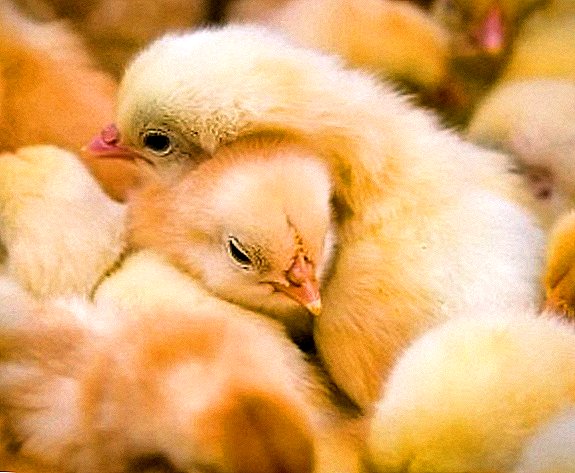 People consider chickens far from being the most developed animals in terms of intelligence, but such an opinion is deeply mistaken. Let's see together why one should not underestimate the mental abilities of these birds, as well as learn 13 interesting facts about chickens and roosters.
People consider chickens far from being the most developed animals in terms of intelligence, but such an opinion is deeply mistaken. Let's see together why one should not underestimate the mental abilities of these birds, as well as learn 13 interesting facts about chickens and roosters.
Chines are not stupid
Domestic chickens have their own organized life, which is subject to a strict schedule: in the evening, as the sun goes down, they go to bed, and in the morning, at dawn, they wake up. There is even such a saying: "Sleep, lie down with the chickens, and wake up with the roosters."
Also feathered pets able to memorize "in the face" of all the relatives in his hen house: if, for example, one of the hens is removed from the herd for several days, then upon return, it will be freely accepted back into the collective. Chickens are also distinguished by a good memory for people's faces, and can remember both good treatment to themselves and bad ones.  Among the abilities of layers there are arithmetic talents. This was proved by Italian scientists led by R. Rugani (Padua University) in the course of their research. They conducted an experiment with newborn chickens, near which they placed five plastic containers from Kinder Surprise. A few days before the eyes of the chicks, the containers were divided, hiding two of them behind one curtain, and three behind the other. Chickens most of all were interested in that screen, where three objects were hidden.
Among the abilities of layers there are arithmetic talents. This was proved by Italian scientists led by R. Rugani (Padua University) in the course of their research. They conducted an experiment with newborn chickens, near which they placed five plastic containers from Kinder Surprise. A few days before the eyes of the chicks, the containers were divided, hiding two of them behind one curtain, and three behind the other. Chickens most of all were interested in that screen, where three objects were hidden.
The history of the domestication of chickens dates back several thousand years. It is assumed that their ancestors were the Bankiv hens, one of the species of wild chickens.
Next, the researchers wanted to test the chickens for their ability to add, subtract, and memorize: in front of them, the scientists took the containers because of one screen and transferred them for another. Interestingly, the chicks still visited that screen, behind which there were more items.  Another experiment consisted in placing cards with numbers near the chickens and hiding food behind them. At first, chickens were trained to look for edible behind a screen with five squares. Later, the chickens were offered two identical cards, and in most cases, if the number exceeded five, the chicken headed for the right card, and when the number was less than five - to the left one.
Another experiment consisted in placing cards with numbers near the chickens and hiding food behind them. At first, chickens were trained to look for edible behind a screen with five squares. Later, the chickens were offered two identical cards, and in most cases, if the number exceeded five, the chicken headed for the right card, and when the number was less than five - to the left one.  As a result of this experiment, the researchers concluded that chickens from early childhood are able to determine where there can be more feed, as well as strive for a larger group of relatives, with whom they can team up to socialize and search for food.
As a result of this experiment, the researchers concluded that chickens from early childhood are able to determine where there can be more feed, as well as strive for a larger group of relatives, with whom they can team up to socialize and search for food.
Did you know? Scientists have concluded that a day-old chicken has the same skills and reflexes as a three-year-old child.
Video: Chicken Experiment
Chickens can communicate
People consider chickens talking to each other with simple clicks and clucking, but in reality, this is the language of communication. Researchers have described over thirty different meanings of bird "conversation"among which are “it's time for me to get in touch,” “rather, everything is here, there is a lot of food here!”, as well as a call from partners during the mating season and a signal that predators are approaching. Mother-hen can quietly communicate with embryos that are still in the egg. And chicks a few days before birth can already respond to mother with certain sounds that express pleasure or anxiety, if the mother herself is calm or anxious.
Later, walking with a brood, the quit always teaches the chickens, emitting various sounds warning about the danger, or urging them to eat something, and the little ones quickly respond to the call, hiding under the mother or gathering in a group near the feed.
Video: cock calls chickens
They have feelings
Another discovery related to chickens is that these domestic birds are capable of experiencing emotions and expressing feelings of compassion and mercy. This made sure the British ornithologists from the University of Bristol, who conducted a curious experiment. During it, chickens and chicks were divided, placing them in different cages, but leaving them in sight of each other.
Then the adult chickens were blown with cold air for some time to make sure that it causes discomfort. After a stream of cold air sent to the chickens. At this time, the chicks, who watched the scientists' actions, began to increase heartbeat, they began to call their chickens and to behave restlessly.  Therefore, ornithologists concluded that domestic chickens are capable of experiencing empathy towards their chicks. In the course of other observations, it turned out that the chicken is able to experience depression if the chick dies, or when it is isolated from the family and placed in a separate cage.
Therefore, ornithologists concluded that domestic chickens are capable of experiencing empathy towards their chicks. In the course of other observations, it turned out that the chicken is able to experience depression if the chick dies, or when it is isolated from the family and placed in a separate cage.
Did you know? Domestic chickens are the most common vertebrate species on the planet: there are about 20 billion individuals.
Roosters predict the weather
For a long time our ancestors noticed that roosters with their singing react to changes in the weather: they can sing at different times of the day before certain weather events. For example:
- if the rooster started singing immediately after sunset, then it means that the weather may change;
- crowing comes out after 22 hours - you need to expect a quiet, windless night;
- the evening "crow" in the summer (up to 21 hours) predicts rain, and in the winter time predicts an early thaw;
- roosters can predict weather changes not only by singing, but also by their behavior;
- when they dig in the ground, they turn their breasts in the direction from which the wind might be strengthened;
- cockfights are predicting good sunny weather;
- in winter, standing on one leg, and picking up the second under him, the rooster predicts increased frost;
- if the rooster began to moult earlier than that of the chickens, then in the fall and winter there will be variable weather, and if the chickens began to shed earlier, then this is towards steady weather.
Did you know? In quiet, windless weather, a rooster's cry can be heard at a distance of more than two kilometers.
Like to make some noise
Chickens are noisy birds, and they like to accompany any changes from outside with hubbub.  Here are some reasons why there may be a commotion in the house:
Here are some reasons why there may be a commotion in the house:
- the owner appeared in the hen house (joy);
- a stranger-man came into the room (anxiety);
- the testicle will be taken soon;
- business took place: I was demolished;
- many goodies found;
- the nest was occupied by an unsolicited commodity;
- a predator (cat, dog) climbed into the chicken coop.
Another reason for the noisy behavior of chickens - the love of communication. If only one of the birds feels anxiety, this feeling is quickly adopted by the other inhabitants of the hen house.
It is interesting to get acquainted with the selection of breeds of chickens with red, white, black, blue plumage.
Love to dig
The love of the chicken family to dig in the garden is known to everyone and can cause irreparable damage to their owner. Looking for food in the land, chickens are able to destroy beds with garden crops on a large area. Also, chicks are not averse to digging holes in the beds and flower beds, and enjoy the "dip" in the sand, scattering around the garden soil. Therefore, the owner must not lose vigilance, if suddenly his pets want to get out of the house and dig in the ground in the wild. 
Rooster - the head of the chicken coop
In the rooster - the main role in the hierarchical system of avian society, which allows him to carry out many organizational duties:
- control of morning awakening of hens (thanks to such control, the owners of the chicken coop wake up);
- a call for feeders with food, as well as goodies found in the wild;
- regulation and prevention of conflicts within the chicken family;
- laying chickens in the nest;
- repelled attacks of small predators.

Roosters are genetically predisposed to leadership qualities and briariness, therefore they often enter into unequal combat with larger enemies, for example, dogs or their own master.
Learn more about the "head of the coop": a variety of nicknames for a rooster; whether a rooster is needed for chickens to fly and how many chickens there should be for one rooster; like a rooster trampling a chicken.
Chicken can be hypnotized
If you want to surprise your friends with your hypnotist's talent, show them an interesting trick using chicken as a visual aid.
To “hypnotize” a chicken, you will need:
- live layer;
- piece of chalk;
- flat surface on which you can write with chalk (asphalt).
Now do the following steps:
- Catch the chicken and calm it down so that it does not resist.
- Then, holding the bird with both hands, carefully lay it on its side.
- Hold the legs with one hand, and leave the neck and head free. Having calmed down, the bird itself will lay its head, as if it was going to sleep.
- With one hand continue to hold the legs, and in the other, take the chalk and attract the attention of the chicken. When she begins to follow the chalk, draw a straight line from her head about 40 cm long.
- Spend chalk several times on the drawn line, until the chicken, watching the line, does not stop completely.
- Gently release the chicken legs. The chicken will remain in the same position and may lie in a daze for up to half an hour.
- Bring the bird to life by slamming its hands over its head. The bird will “come to life” and jump, looking at the assembled spectators with surprise.
Important! When focusing on hypnosis, remember that if the bird resists, rough treatment is unacceptable. It is also inhuman for a long time to leave the chicken lying in a daze.
Of course, this is not hypnosis. Ornithologists give a logical explanation for this behavior of birds: instinctively feeling the danger and being subjected to stress, the bird can pretend to be dead.
Video: Chicken Hypnosis
Chickens - descendants of dinosaurs
Evolutionary scientists from the University of Kent (UK) consider chickens to be direct descendants of tyrannosaurs because of their similarities in basic habits:
- chickens can be well oriented in space;
- run fast;
- good to see;
- lay eggs;
- if necessary, choose attack tactics.
 Also in the genome of birds was found the similarity of the cellular structures of chickens and dinosaurs. It is believed that the chickens have undergone the smallest number of changes in the course of evolution compared to other birds.
Also in the genome of birds was found the similarity of the cellular structures of chickens and dinosaurs. It is believed that the chickens have undergone the smallest number of changes in the course of evolution compared to other birds.Check out the collections of breeds of chickens: the most unusual, the largest, decorative, fighting; with shaggy paws, tufts, the largest eggs.
Rooster can live without a head
It happens that after slaughter, the chicken can move for a while even without a head. This is due to the fact that the body of the headless bird continues to produce nerve impulses.  A similar incident occurred at 1945 in the town of Fruta in the USA, on the farm of L. Olsen. To prepare the dinner, the farm owner decided to score a rooster named Mike, but the overlooked fragment of the poor bird missed and cut off with an ax, leaving one ear and part of the brain stem. The wounded cock jumped and began to run around the yard.
A similar incident occurred at 1945 in the town of Fruta in the USA, on the farm of L. Olsen. To prepare the dinner, the farm owner decided to score a rooster named Mike, but the overlooked fragment of the poor bird missed and cut off with an ax, leaving one ear and part of the brain stem. The wounded cock jumped and began to run around the yard.  The bird was left alive for the sake of the experiment: how much it can live this way. The rooster was pipetted with milk, burying him right down his throat. Scientists from the University of Utah were interested in this case and they documented this phenomenon and determined that the rooster stayed alive due to the fact that the carotid artery was not damaged during the ax strike. Also, the brain site that remained intact was responsible for the vital functions of the body and allowed the rooster to survive.
The bird was left alive for the sake of the experiment: how much it can live this way. The rooster was pipetted with milk, burying him right down his throat. Scientists from the University of Utah were interested in this case and they documented this phenomenon and determined that the rooster stayed alive due to the fact that the carotid artery was not damaged during the ax strike. Also, the brain site that remained intact was responsible for the vital functions of the body and allowed the rooster to survive.  Subsequently, Mike recovered from the injury and was able to live another 18 months. During this time, L. Olsen participated in public demonstrations of this phenomenon with Mike, but once he forgot to feed him after the tour, after which the rooster died (or suffocated from the trachea breaking, according to another version). The case with Mike is one of a kind, so he took an honorable place in the Guinness Book of Records.
Subsequently, Mike recovered from the injury and was able to live another 18 months. During this time, L. Olsen participated in public demonstrations of this phenomenon with Mike, but once he forgot to feed him after the tour, after which the rooster died (or suffocated from the trachea breaking, according to another version). The case with Mike is one of a kind, so he took an honorable place in the Guinness Book of Records.  Celebration of Mike's Headless Chicken Day. Subsequently, the headless rooster became a symbol of the town of Frut and every year in May, Mike's Day is held there, during the celebration of which a egg throwing contest is held.
Celebration of Mike's Headless Chicken Day. Subsequently, the headless rooster became a symbol of the town of Frut and every year in May, Mike's Day is held there, during the celebration of which a egg throwing contest is held.
Did you know? Despite the fact that most people are touched by fluffy, tiny chickens, some people have an electrophobia - the fear of chickens and chickens. Suffering from this disorder, such people fear that the birds may behave aggressively and, hiding, to attack them.
Black cocks and chickens
There is a unique breed of Ayam Chemani chickens, completely painted in a noble black color. Black in birds is absolutely everything - plumage, eyes, a comb with earrings, as well as paws and claws. The meat is also black, but it does not differ in taste from regular chicken.  Black feathers come from the Indonesian islands, are very rare in our open spaces, so they are expensive. Interestingly, in their homeland, in Indonesia, black roosters are used in religious rituals to increase the birth rate of the population. Even local residents have the belief that crowing a rooster Ayam Chemani brings good luck, and the use of baked or cooked meat can alleviate the torments of conscience.
Black feathers come from the Indonesian islands, are very rare in our open spaces, so they are expensive. Interestingly, in their homeland, in Indonesia, black roosters are used in religious rituals to increase the birth rate of the population. Even local residents have the belief that crowing a rooster Ayam Chemani brings good luck, and the use of baked or cooked meat can alleviate the torments of conscience.
Read also about the best breeds of chickens and the basics of breeding and keeping chickens for beginners.
Cause addiction
Specialists in the field of psychology have made a discovery: the breeding of chickens can be addictive in humans. This phenomenon occurs as follows: starting to engage in breeding poultry from a small chicken family of 5-10 individuals, a person can become addicted to the process and later on his farm can already number up to 200 individuals of different chicken breeds, with various indicators of egg production and productivity.  By the time the poultry farmer decides on his favorite breed, his farm may turn into a solid poultry farm.
By the time the poultry farmer decides on his favorite breed, his farm may turn into a solid poultry farm.
Important! Chickens love to drink water, and their egg production and well-being directly depends on it. Therefore, reducing for them the norms of drinking, breeders risk getting a reduction in their egg production by more than 15%.
Do not carry eggs every day
The egg production of each chicken is individual and depends on the breed, feed, length of daylight, health and conditions in the chicken coop. On average, in the hen's body, each egg matures in 25 hours, and each subsequent one develops after a certain period of time after the previous one. Thus, the egg laying time is shifted daily to a later date, as a result of which a day comes when the chicken does not carry the testicle. Meat chickens have a longer egg-carrying cycle than egg breeds.
Learn more about chicken production: the period of egg production in young pullets, how many years the laying hens have been born; structure, weight, categories, benefits of chicken eggs; why do eggs with two yolks, without shell, green yolk.
Video: interesting and funny about chickens
As you can see, the chickens are very interesting and unique creatures with a certain intelligence, character, feelings and emotions. Also, many domestic chickens have a decorative appearance and can cause addiction in humans. We hope that having got acquainted with interesting facts about chickens in an article, you learned something new about them.












